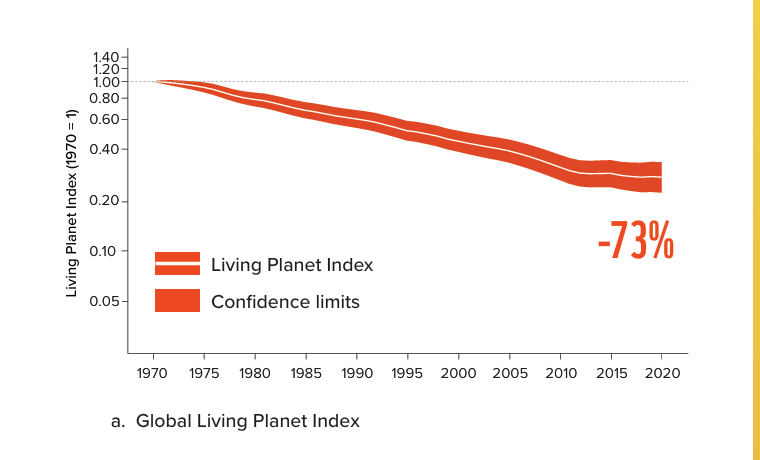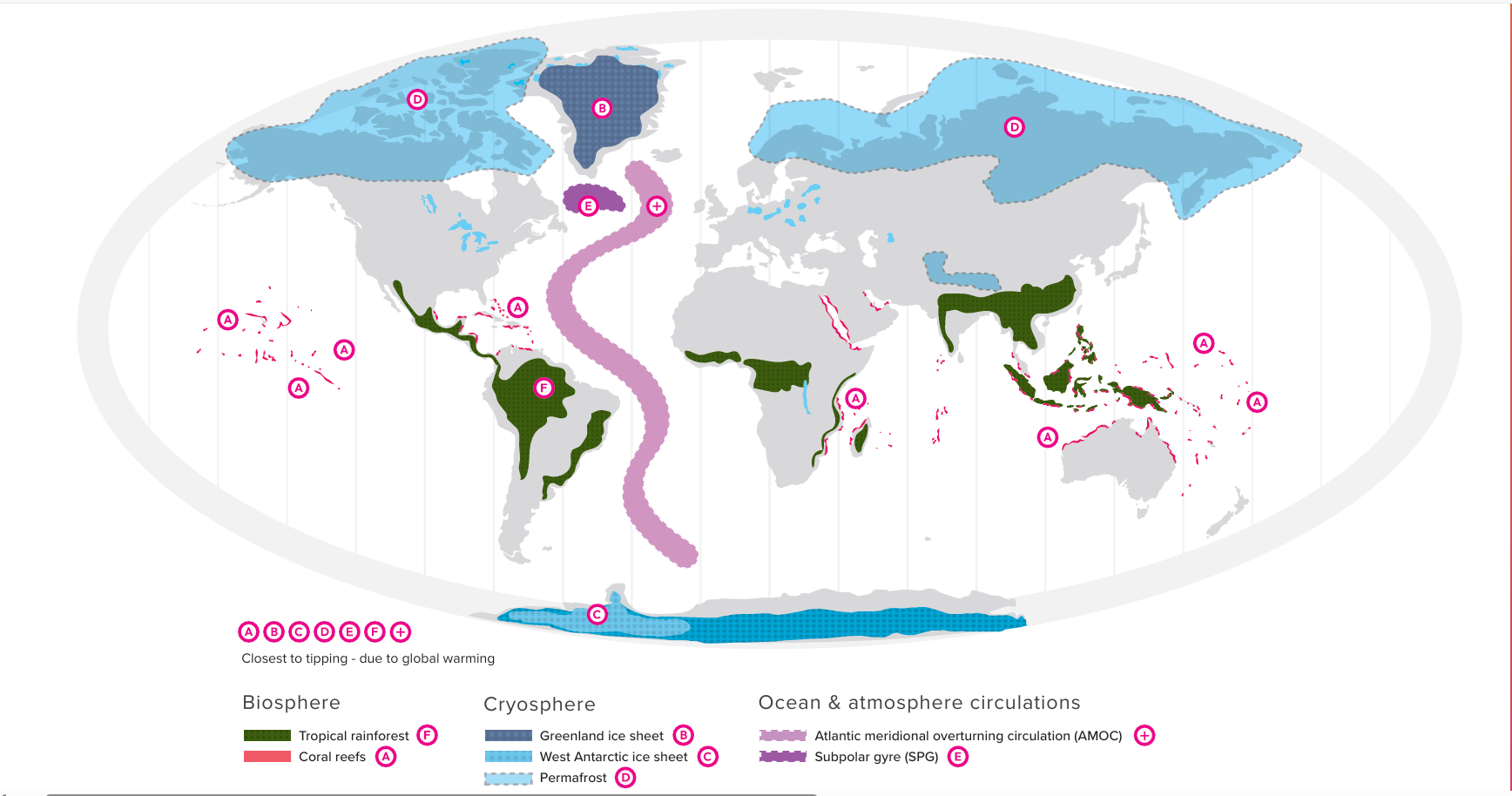Living Planet Report 2024 | 15 Oct 2024
For Prelims: World Wide Fund for Nature (WWF), Living Planet Report 2024, Zoological Society of London (ZSL), Tipping points, Brazilian Atlantic Forest, Sustainable Development Goals, Arctic Circle, Pollution.
For Mains: Threats to Biodiversity, Challenges and suggestive measures to ensure sustainable ecosystems.
Why in News?
According to the World Wide Fund for Nature (WWF)’s Living Planet Report 2024, there has been a catastrophic 73% decline in the average size of monitored wildlife populations in just 50 years (1970-2020).
- The highest decline was reported in freshwater ecosystems (85%), followed by terrestrial (69%) and marine (56%).
World Wildlife Fund for Nature
- It is the world’s leading conservation organization and works in more than 100 countries.
- It is an international non-governmental organization,established in 1961 and is headquartered at Gland, Switzerland.
- Its mission is to conserve nature and reduce the most pressing threats to the diversity of life on Earth.
- WWF collaborates at every level with people around the world to develop and deliver innovative solutions that protect communities, wildlife, and the places in which they live.
- World Wide Fund for Nature-India, commonly referred to as WWF-India, was established as a charitable trust in 1969.
- It operates through an autonomous structure, with its Secretariat located in New Delhi, along with multiple state, divisional, and project offices distributed across India.
What is the Living Planet Report and its Key Findings?
- About:
- The WWF utilises the Living Planet Index (LPI) to track average trends in wildlife populations. It monitors broader changes in species population sizes over time.
- The Living Planet Index, released by the Zoological Society of London (ZSL), monitors nearly 35,000 vertebrate populations across 5,495 species from 1970 to 2020.
- It acts as an early warning system for extinction risks and also helps evaluate the overall health and efficiency of ecosystems.
- The WWF utilises the Living Planet Index (LPI) to track average trends in wildlife populations. It monitors broader changes in species population sizes over time.
- Key Findings:
- Significant Population Declines: The steepest declines in monitored wildlife populations are recorded in Latin America and the Caribbean (95%), Africa (76%) and Asia–Pacific (60%) and in freshwater ecosystems (85%).
- Primary Threats to Wildlife: Habitat loss and degradation, is the most reported threat to wildlife populations around the world, followed by overexploitation, invasive species and disease.
- Indicators of Ecosystem Health: Declines in wildlife populations can act as an early warning indicator of increasing extinction risk and loss of healthy ecosystems.
- Damaged ecosystems become more vulnerable to tipping points which are pushed beyond a critical threshold toward potentially irreversible change.
- For example, a study in the Brazilian Atlantic Forest indicates that the loss of large fruit-eating animals has reduced seed dispersal for large-seeded trees, which affects carbon storage.
- The WWF warns that this phenomenon could lead to carbon storage losses of 2-12% across forests in Africa, Latin America, and Asia, diminishing their ability to store carbon amid climate change.
- Vulnerability of Damaged Ecosystems: There are global agreements and solutions to set nature on the path to recovery by 2030, but so far there has been limited progress, and urgency is lacking.
- More than half of the UN-mandated Sustainable Development Goals for 2030 are unlikely to meet their targets, with 30% already missed or worse than their 2015 baseline.
- Economic Impacts: Globally, over half of GDP (55%) is moderately or highly dependent on nature and its services.
- The report estimates that by 2050, the world would only need 0.84 of an Earth to sustain food production if India’s diet model were adopted worldwide.
- Threats to Biodiversity:
- Habitat Degradation and Loss: Deforestation, urbanization, and agricultural expansion are leading causes of habitat destruction. These activities fragment ecosystems, leaving species with less space and resources to survive.
- The Sacramento river winter-run Chinook salmon population decreased by 88% between 1950 and 2020, primarily due to dams disrupting their migratory routes.
- Overexploitation: Excessive hunting, fishing, and logging for commercial purposes are depleting wildlife populations faster than they can recover, pushing many species toward extinction.
- In Africa, poaching for the ivory trade has led to a 78-81% decline in forest elephant populations in Minkébé National Park from 2004 to 2014.
- Invasive Species: Non-native species introduced by humans often outcompete local species for resources, destabilising ecosystems and reducing biodiversity.
- Climate Change: Rising temperatures, shifting weather patterns, and extreme events are altering habitats, threatening species that cannot adapt quickly enough.
- Wildfires are becoming longer, with extreme fire events occurring more frequently, even reaching the Arctic Circle.
- Pollution: Industrial waste, plastic pollution, and agricultural runoff contaminated ecosystems, poisoning wildlife and disrupting the balance of natural processes.
- Critical Tipping Points: These refer to irreversible changes in ecosystems that, once crossed, lead to dramatic shifts.
- Coral Reef Bleaching: Mass coral die-offs could destroy fisheries and coastal protection, affecting millions of people.
- Amazon Rainforest: Continued deforestation could disrupt global weather patterns and release vast amounts of carbon, intensifying climate change.
- Greenland & Antarctic Ice Melt: Melting ice sheets would lead to significant sea level rise, impacting coastal regions globally.
- Ocean Circulation: The collapse of ocean currents could alter weather in Europe and North America.
- Permafrost Thaw: Large-scale thawing could release vast amounts of methane and carbon, accelerating global warming.
- Habitat Degradation and Loss: Deforestation, urbanization, and agricultural expansion are leading causes of habitat destruction. These activities fragment ecosystems, leaving species with less space and resources to survive.
What are the Challenges Related to Conservation of Biodiversity?
- Conflicting Priorities: Balancing conservation with economic growth can be challenging, especially in developing nations where short-term economic gains often take precedence over long-term ecological sustainability.
- Resource Allocation: Limited financial resources and competing budget priorities make it difficult for governments to invest in large-scale biodiversity conservation efforts while addressing pressing social needs.
- Agricultural Expansion: Meeting food security goals can conflict with habitat protection, as land for agriculture encroaches on ecosystems, particularly in biodiversity hotspots.
- Issue in Energy Transition: Shifting to renewable energy can impact ecosystems through land-use changes (e.g., solar farms, wind turbines), creating trade-offs between environmental protection and energy needs.
- Policy and Enforcement Gaps: Weak institutional frameworks and inconsistent enforcement of environmental regulations at both global and national levels hinder effective biodiversity protection, allowing unsustainable practices to continue unchecked.
Way Forward
- Scaling up Conservation Efforts: Increase and improve the effectiveness of conservation initiatives by expanding protected areas, restoring degraded ecosystems, and supporting Indigenous Peoples in conservation efforts.
- Transforming Food Systems: Adopt sustainable agricultural practices, reduce food waste, and promote plant-based diets to lessen the environmental impact of food production on biodiversity.
- Energy Transition: Accelerate the shift to renewable energy sources while ensuring minimal harm to ecosystems, reducing dependency on fossil fuels, and limiting climate change impacts.
- Finance System Reform: Redirect financial investments away from harmful industries toward nature-positive and sustainable activities, ensuring long-term environmental benefits.
- Global Cooperation: Foster stronger international collaboration on biodiversity protection, aligning climate, nature, and development policies to achieve global sustainability goals.
|
Drishti Mains Question: Discuss the major threats to biodiversity and suggest transformative solutions to ensure sustainable ecosystems for future generations. |
UPSC Civil Services Examination, Previous Year Question (PYQ)
Prelims:
Q. Consider the following statements: (2018)
- The definition of “Critical Wildlife Habitat” is incorporated in the Forest Rights Act, 2006.
- For the first time in India, Baigas have been given Habitat Rights.
- Union Ministry of Environment, Forest and Climate Change officially decides and declares Habitat Rights for Primitive and Vulnerable Tribal Groups in any part of India.
Which of the statements given above is/are correct?
(a) 1 and 2 only
(b) 2 and 3 only
(c) 3 only
(d) 1, 2 and 3
Ans: (a)
Mains:
Q. What are the consequences of Illegal mining? Discuss the Ministry of Environment and Forests’ concept of GO AND NO GO zones for coal mining sector. (2013)


